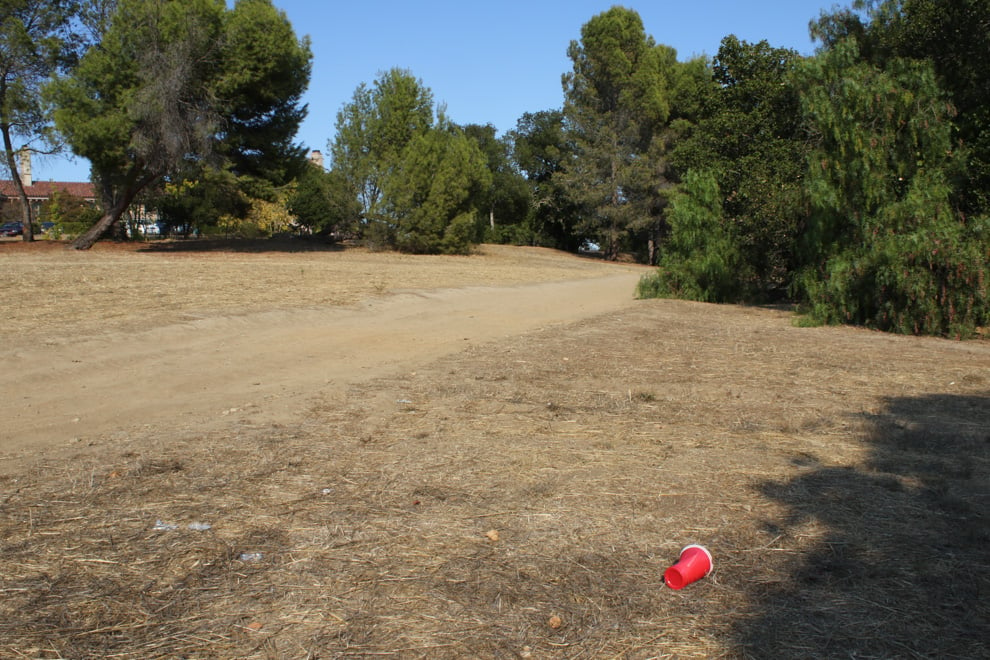The path between Enchanted Broccoli Forest (EBF) and Kappa Alpha (KA) fraternity house, known to students as “scary path,” has been recently fenced off with bollards and chains on both sides and a sign barring entry. However, some students believe more is needed to make the path safe.
Stanford’s measures to prevent unsanctioned use of the path follow creation of a task force, called the Knoll Path Working Group, dedicated to addressing safety concerns of students using the path as a shortcut home from late-night events. While the University has no immediate plans to modify the dirt path itself, this group is working to build a walkway and install lighting.
The Knoll Path Working Group consists of four undergraduate students, a graduate student and five administrators, including Vice Provost for Student Affairs Greg Boardman, who co-chairs the task force with Alexis Kallen ’18.
Kallen has led the initiative to improve student safety in the “scary path” area since last year, after working as an executive fellow for the Associated Students of Stanford University (ASSU). Kallen said she was alarmed when she received numerous emails from students expressing concern about the rocky and dangerous path where many had fallen or were afraid of being attacked.
Kallen said approximately 85 percent of the emails she received about “scary path” expressed a fear of sexual assault.
The 528-foot-long dirt path, which takes approximately two minutes to walk, is isolated and dark at night, and surrounded by a wooded area. Last January, former Stanford varsity swimmer Brock Turner was allegedly found sexually assaulting an unconscious woman about ten feet from the path, according to a brief written by Kallen and Elizabeth Woodson ’15, former ASSU president.
Several students quoted in the brief mentioned that they frequent the path in order to reach KA and other fraternities, especially on weekend nights. Kallen said that members of Greek life, especially the Kappa Sigma and KA fraternities, have been “very supportive” of efforts to make the area safer.
Jordan Parker ’18, who works closely with Kallen as part of the task force, said concerns about “scary path” have an extensive history.
“It goes back, I think, six or seven years that students have felt that this is something that needed to be addressed,” Parker said.
The recently created task force marks the first concrete effort to combat the issue.
At the Knoll Path Working Group’s first meeting in mid-February, members discussed potential approaches to improve safety and security for students using the path, including constructing a paved and lighted pathway.
The University said it has not made improvements to the path, and does not currently intend to, because the route is not a legal thoroughfare.
“The path in question has never been a University-sanctioned transportation route; it is a shortcut that students elected to take instead of staying on lighted, paved pathways as is advised by campus police and the University,” wrote University spokesperson Lisa Lapin in an email. “Because it is not a University path, yet students have continued to choose to use it, the University has installed chains and “no entry” signs.”
However, Lapin also noted that “there are ongoing discussions with a working group of students and staff to study the options.”
“I think there has been some implication that students just shouldn’t be drinking or that [the University] can’t be responsible for their behavior if they decide to cut through,” said Lily Lamboy M.A. ’13, a fourth-year Ph.D. student on the task force.
However, students like Lamboy and Kallen are pushing to improve the existing pathway rather than encourage alternative routes. Lamboy and Kallen both pointed out that students prioritizing efficiency and speed over safety might not be deterred from using the path despite the fence and signs.
One student living in nearby Narnia house, who preferred not to be named, confirmed this intuition, saying, “basically [the path] being roped off is completely ignored by everyone.”
Several Knoll Path Working Group members emphasized the importance of listening to student concerns and making safety accessible.
“It’s important to recognize that especially late at night, people really want to get home quickly,” Lamboy said. “And right now there’s not a very efficient or quick way to get from one place to another, so people use this as a cut-through. I see that as a safety trade-off, and that’s a bad trade-off for students to have to make.’’
Conservationists have raised concerns that paving “scary path” would destroy the ecological habitat of an endangered species of salamanders living in the area around Lake Lagunita. But both Kallen and Lamboy believe it is possible to work around the endangered salamanders species in a collaborative effort.
An elevated boardwalk would be one way to provide a safe and lighted pathway without disrupting the salamanders, Kallen said. Furthermore, the boardwalk would provide ease of access for individuals with disabilities and eliminate the need to level the pathway.
Knoll Path Working Group members are also looking at additional measures, such as putting up a map near the path and giving comprehensive campus tours to new undergraduate and graduate students to help them understand campus geography and minimize their chances of getting lost in an unfamiliar part of campus.
Joy Leighton, communications director for Student Affairs, said in an email that Boardman is working with the Knoll Path Working Group to draft an informational email to students about the path, which will be sent at the end of March.
Contact Sandra Ortellado at sortella ‘at’ stanford.edu.
